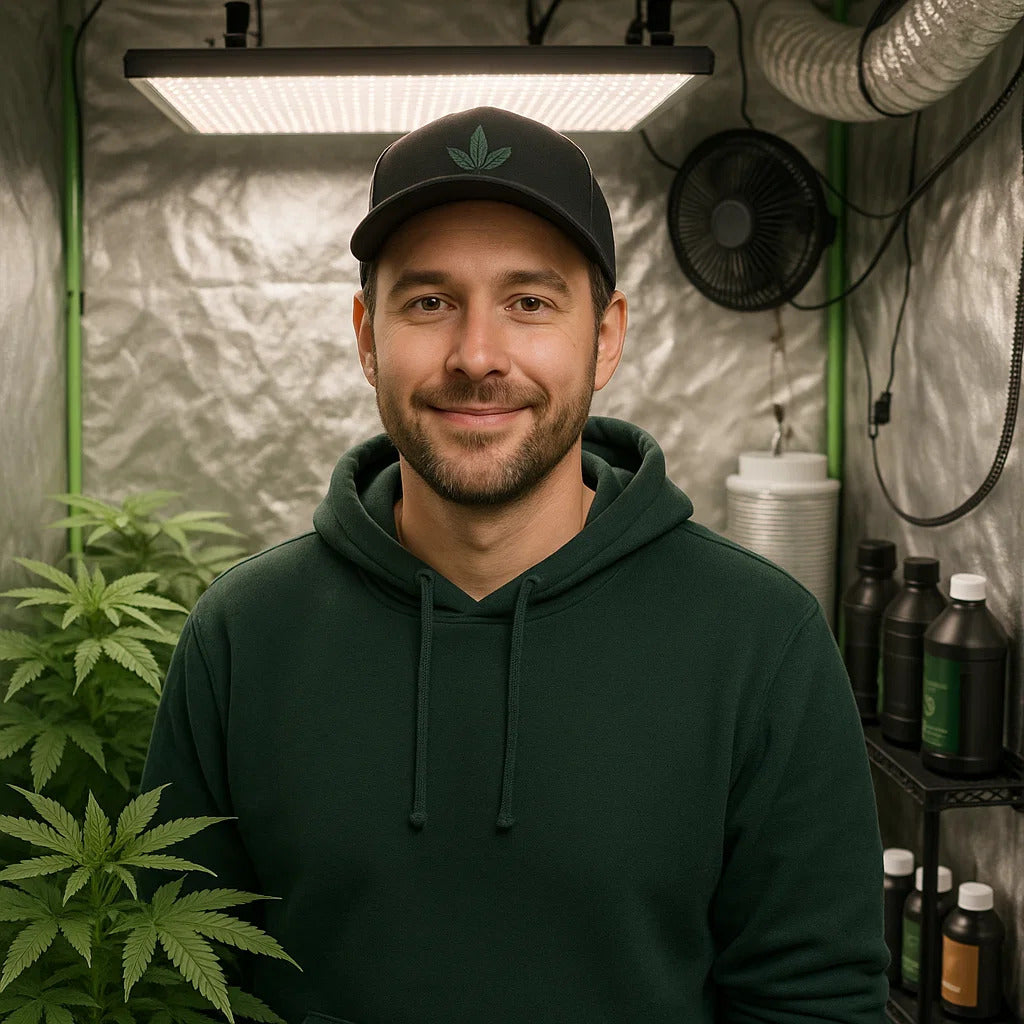
Best Full Spectrum LED Grow Lights 2025: Top Reviews & Buying Guide
The quest for the best full spectrum LED grow lights has reached new heights in 2025, as advanced technology delivers unprecedented control over plant development and harvest quality. Modern full spectrum LEDs have evolved far beyond simple white light panels, incorporating sophisticated spectrum tuning, intelligent automation, and precision wavelength targeting that enables growers to unlock their plants' full genetic potential. These revolutionary lighting systems represent the culmination of decades of horticultural research, offering energy efficiency, longevity, and performance that dramatically surpasses traditional growing methods.

Today's best full spectrum LED grow lights integrate seamlessly with smart growing systems, providing automated environmental control that transforms cultivation from a labor-intensive process into a precision science. With features like smartphone connectivity, adaptive spectrum adjustment, and machine learning optimization, these advanced systems enable both novice and expert growers to achieve consistent, professional-quality results.
Understanding Full Spectrum LED Technology
The Science Behind Complete Spectrum Coverage
True full spectrum LED grow lights encompass the entire photosynthetically active radiation (PAR) range of 400-700 nanometers, while extending into beneficial UV and far-red wavelengths that trigger specific plant responses. Unlike generic white LEDs designed for human vision, the best full spectrum grow lights utilize carefully calibrated diode combinations that optimize photosynthetic efficiency while minimizing energy waste.
Modern full spectrum designs incorporate multiple wavelength peaks strategically positioned to match plant absorption curves. Blue wavelengths (400-500nm) drive chlorophyll production and compact vegetative growth, while red wavelengths (600-700nm) fuel flowering and fruiting processes. Advanced models add UV wavelengths that stimulate essential oil production and far-red light that influences plant morphology and flowering responses.
Targeted Full Spectrum vs. Generic White Light
The distinction between targeted full spectrum and generic white light represents one of the most significant advances in LED grow light technology. The Gorilla Xi Series LED Grow Lights exemplify this evolution with their precisely engineered spectrum that maximizes usable photons while eliminating wavelengths that contribute little to plant growth.
Generic white LEDs waste significant energy producing green wavelengths that plants reflect rather than absorb. Targeted full spectrum designs concentrate energy in wavelengths plants actually use, delivering superior photosynthetic efficiency and improved growth responses while reducing electricity consumption.
Top Full Spectrum LED Grow Light Categories for 2025
Premium Smart Growing Systems
Leading the market in 2025, intelligent full spectrum systems like the Gorilla Xi750 LED Grow Light combine advanced spectrum control with wireless automation that revolutionizes indoor growing. These sophisticated systems feature tri-channel spectrum control enabling precise adjustment of blue, red, and supplemental wavelengths throughout different growth phases.
The GXi wireless technology transforms growing from guesswork into precision agriculture, with automated environmental protection, sunrise/sunset simulation, and adaptive spectrum adjustment based on real-time growing conditions. Professional growers particularly value the ability to create custom light schedules that optimize each growth stage while maximizing energy efficiency.
High-Performance Multi-Bar Fixtures
Multi-bar LED designs have emerged as the preferred configuration for serious growers, offering superior light distribution and thermal management compared to traditional panel designs. These fixtures feature multiple parallel light bars that create even coverage while allowing better airflow through plant canopies.
The Gorilla Xi420 LED Grow Light represents this advanced approach with its optimized bar configuration that delivers uniform PPFD across entire growing areas. The distributed design also enables passive cooling that extends component lifespan while reducing grow space temperatures.
Value-Oriented Professional Options
Budget-conscious growers no longer need to sacrifice quality for affordability, as modern manufacturing has made professional-grade features accessible across price ranges. The Gorilla Xi330 LED Grow Light demonstrates this evolution, offering targeted full spectrum performance and intelligent controls at accessible pricing.
These value-oriented options typically provide excellent spectrum quality and efficiency ratings while focusing on core functionality rather than advanced automation features. They represent ideal starting points for new growers or cost-effective solutions for expanding existing operations.
Key Features in the Best Full Spectrum LED Grow Lights
Advanced Spectrum Control and Customization
The ability to adjust spectrum composition throughout growing cycles represents one of the most valuable features in modern LED systems. Advanced models offer separate control channels for different wavelength groups, enabling growers to optimize lighting for specific plant varieties and growth stages.
Professional systems provide preset programs for common growing scenarios while allowing complete customization for specialized applications. This flexibility enables growers to experiment with lighting recipes that maximize yield, potency, and quality according to their specific objectives.
Energy Efficiency and Heat Management
Superior energy efficiency distinguishes premium full spectrum LEDs from budget alternatives, with top systems achieving efficacy ratings exceeding 2.8 µmol/J. This efficiency translates directly into reduced electricity costs and improved environmental sustainability for growing operations.
Advanced thermal management systems incorporate large aluminum heat sinks, passive cooling designs, and remote driver mounting that minimizes heat generation within growing spaces. This superior heat control enables closer light positioning for maximum intensity while reducing cooling requirements.
PPFD Output and Coverage Uniformity
Photosynthetic Photon Flux Density (PPFD) measurements provide the most accurate indicator of grow light performance, representing actual photon delivery to plant surfaces. The best full spectrum LED grow lights deliver high PPFD values with exceptional uniformity across their coverage areas.
Quality manufacturers provide detailed PPFD maps showing light distribution patterns at various mounting heights, enabling growers to optimize positioning for their specific growing areas and plant requirements.
Sizing and Coverage Optimization
Calculating Light Requirements for Growing Spaces
Proper LED sizing requires understanding PPFD requirements for specific plant varieties and growth stages. Most flowering plants require 600-1000 µmol/m²/s during bloom periods, while vegetative growth typically needs 400-600 µmol/m²/s for optimal development.
Calculate total photon requirements by multiplying your growing area by target PPFD values, then select LEDs with appropriate PPF (Photosynthetic Photon Flux) ratings to achieve desired intensity levels. Account for mounting height and natural efficiency losses when making final selections.
Multi-Light Configurations and Expansion
Large growing operations often benefit from multiple LED fixtures rather than single high-wattage units, providing better light distribution and operational flexibility. This approach enables zone-specific control and gradual system expansion as operations grow.
Consider fixture spacing and overlap patterns when designing multi-light installations, ensuring even coverage while avoiding excessive intensity zones that could stress plants or waste energy.
Installation and Setup Best Practices
Mounting Height and Positioning Strategies
Optimal mounting height balances light intensity with coverage uniformity, typically ranging from 18-36 inches above plant canopies depending on fixture design and power output. Higher mounting provides broader coverage but reduces intensity, while lower positioning maximizes PPFD but may create hot spots.
Monitor plant responses carefully during initial setup, adjusting height based on growth patterns and any signs of light stress. Quality LED systems typically include hanging hardware that enables easy height adjustments as plants develop.
Environmental Integration and Control
Modern full spectrum LEDs integrate seamlessly with comprehensive environmental control systems, enabling coordinated management of lighting, temperature, humidity, and air circulation. This integration maximizes efficiency while ensuring optimal growing conditions throughout all development stages.
Program lighting schedules that complement natural daily cycles while optimizing electricity rates and cooling requirements. Smart systems can automatically adjust schedules based on external conditions and energy costs.
Spectrum Optimization for Different Growth Stages
Vegetative Growth Programming
Vegetative growth responds best to blue-heavy spectrums that promote compact growth, robust stem development, and healthy leaf formation. Advanced systems enable precise blue/red ratios that encourage desired plant architecture while maintaining vigorous growth rates.
The optimal vegetative spectrum typically emphasizes blue wavelengths while providing sufficient red content to support photosynthetic efficiency. Avoid excessive far-red during vegetative stages to prevent unwanted stretching.
Flowering and Fruiting Enhancement
Flowering stages benefit from increased red wavelengths and the addition of far-red and UV content that triggers reproductive responses and enhances secondary metabolite production. Advanced systems provide separate channels for these supplemental wavelengths, enabling precise timing of their introduction.
Begin transitioning spectrum composition 1-2 weeks before switching to flowering photoperiods, gradually increasing red content while maintaining sufficient blue light for continued healthy development.
Energy Efficiency and Operating Economics
Calculating Total Cost of Ownership
Evaluate LED investments based on total cost of ownership including purchase price, energy consumption, and expected lifespan rather than initial cost alone. Premium systems often provide superior long-term value through reduced energy usage and extended operational life.
Consider local electricity rates and growing schedules when calculating operational costs, as lighting typically represents the largest energy expense in indoor growing operations. High-efficiency LEDs can reduce lighting costs by 40-60% compared to traditional alternatives.
Return on Investment Analysis
Quality full spectrum LEDs typically pay for themselves within 2-3 years through energy savings and improved yields, with continued benefits throughout their 5-10 year operational lifespans. Factor improved crop quality and reduced cooling costs into ROI calculations for complete financial analysis.
Premium systems with advanced controls often enable additional savings through precise energy management and optimized growing cycles that reduce overall production costs while improving harvests.
Maintenance and Longevity Optimization
Preventive Care and Cleaning Procedures
Regular maintenance ensures sustained performance throughout LED lifespans, with monthly cleaning removing dust accumulation that can reduce light output by 10-15%. Use soft, dry cloths to clean LED surfaces and heat sinks, avoiding moisture or cleaning agents that could damage components.
Monitor mounting hardware for looseness and inspect electrical connections periodically to prevent safety issues and maintain optimal performance. Quality systems typically require minimal maintenance when properly installed.
Performance Monitoring and Optimization
Track light output using PAR meters to detect degradation before it affects plant health, documenting baseline measurements for future comparison. Most quality LEDs maintain 90% of initial output after 50,000+ hours of operation.
Smart systems often include diagnostic features that monitor performance and alert users to potential issues before failures occur, enabling proactive maintenance that prevents unexpected disruptions.
Future Technology and Innovation Trends

Artificial Intelligence and Machine Learning Integration
The integration of AI and machine learning represents the next frontier in LED grow light technology, with systems that automatically optimize spectrum and timing based on plant responses and environmental conditions. These advances promise even greater efficiency and simplified operation.
Future systems will likely incorporate computer vision and sensor networks that continuously monitor plant health and adjust lighting parameters in real-time to maximize growth and quality outcomes.
Sustainability and Environmental Impact
Increasing focus on sustainable growing practices drives continued LED efficiency improvements and the development of recyclable components and eco-friendly manufacturing processes. Advanced systems contribute to reduced carbon footprints while enabling year-round local food production.
Energy efficiency improvements and smart controls help minimize environmental impact while reducing operational costs, making sustainable growing more economically viable for operations of all sizes.
Making Your Selection Decision
Choosing the best full spectrum LED grow lights requires careful consideration of your specific growing objectives, space requirements, budget constraints, and desired automation level. The Gorilla Xi LED Series represents the current pinnacle of full spectrum technology, offering unmatched spectrum control, intelligent automation, and proven performance that delivers consistent professional results.
Consider your long-term growing plans when making LED investments, as quality systems provide years of reliable service while offering upgrade paths for advanced features. The superior efficiency, spectrum quality, and automation capabilities of premium systems typically justify their investment through improved yields, reduced costs, and simplified operation.
Remember that lighting represents the foundation of successful indoor growing - investing in quality full spectrum LEDs enables your plants to reach their full genetic potential while providing the control and consistency necessary for predictable, high-quality harvests season after season.

Lena Myles
I'm a mushroom enthusiast and home cook based in Oregon. I'm passionate about foraging and creating fungi-focused recipes, especially delicious, plant-based dishes using gourmet mushrooms like trumpet, shiitake, and oyster. When I’m not in the kitchen, you’ll usually find me wandering the woods in search of new wild flavors.



